Education > QUESTIONS & ANSWERS > Test Bank Chapter 10 Acquisition and Disposition of Property, Plant, and Equipment. (All)
Test Bank Chapter 10 Acquisition and Disposition of Property, Plant, and Equipment.
Document Content and Description Below
Test Bank Chapter 10 Acquisition and Disposition of Property, Plant, and Equipment. CHAPTER 10 ACQUISITION AND DISPOSITION OF PROPERTY, PLANT, AND EQUIPMENT IFRS questions are av... ailable at the end of this chapter. TRUe-FALSe—Conceptual Answer No. Description F 1. Nature of property, plant, and equipment. T 2. Nature of property, plant, and equipment. F 3. Cost of removing old building. T 4. Insurance on equipment purchased. F 5. Accounting for special assessments. T 6. Overhead costs in self-constructed assets. F 7. Overhead costs in self-constructed assets. F 8. Interest capitalization. F 9. Qualifying assets for interest capitalization. T 10. Avoidable interest. T 11. Interest capitalization on land purchase. T 12. Deferred-payment contracts. T 13. Accounting for nonmonetary exchanges. F 14. Nonmonetary exchanges. F 15. Recognizing losses on nonmonetary exchanges. T 16. Costs subsequent to acquisition. T 17. Definition of improvements. F 18. Ordinary repairs benefit period. F 19. Involuntary conversion gains/losses. T 20 Loss from scrapped asset. Multiple Choice—Conceptual Answer No. Description d 21. Definition of plant assets. b 22. Characteristics of plant assets. d 23. Characteristics of plant assets. c 24. Composition of land cost. c 25. Composition of land cost. c 26. Determination of land cost. d 27. Determine cost of land used as a parking lot. a 28. Determine cost of machinery. b 29. Classification of fences and parking lots. b S30. Recording plant assets at historical cost. d S31. Accounting for overhead costs. d 32. Determine costs capitalized for self-constructed assets. d 33. Assets which qualify for interest capitalization. a 34. Assets which qualify for interest capitalization. c 35. Definition of "avoidable interest." a 36. Period of time over which interest may be capitalized. b 37. Maximum amount of annual interest that may be capitalized. Multiple Choice—Conceptual (cont.) Answer No. Description b 38. Interest capitalization—weighted-average factor. d 39. Classification of interest earned on securities purchased with borrowed funds. d 40. Write-off of capitalized interest costs. c S41. Conditions for interest capitalization. a S42. Capitalization of interest on constructed assets. c S43. Nonmonetary exchanges and culmination of earning process. a S44. Recognizing gains/losses in exchange having commercial substance. a S45. Valuation of nonmonetary asset. b P46. Gain recognition on plant asset exchange. c 47. Valuation of plant assets. d 48. Plant asset acquired by issuance of stock. d 49. Valuation of nonmonetary exchanges. a 50. Gain recognition on a nonmonetary exchange. c 51. Gain recognition on a nonmonetary exchange. b 52. Accounting for donated assets. b 53. Valuation of donated assets. d 54. Identify conditions for capital expenditures. c 55. Capital expenditure. d 56. Identification of a capital expenditure. a 57. Identification of a capital expenditure. c P58. Accounting for revenue expenditures. d S59. Accounting for capital expenditures. a S60. Gain or loss on plant asset disposal. d 61. Determine loss on sale of depreciable asset. c 62. Knowledge of involuntary conversions. P These questions also appear in the Problem-Solving Survival Guide. S These questions also appear in the Study Guide. Multiple Choice—Computational Answer No. Description b 63. Determine cost of land. d 64. Determine cost of building. d 65. Calculate cost of land and building. c 66. Calculate cost of equipment. c 67. Calculate cost of equipment. d 68. Overhead included in self-constructed asset. d 69. Overhead included in self-constructed asset. a 70. Calculate interest to be capitalized. b 71. Calculate average accumulated expenditures. a 72. Calculate interest to be capitalized. b 73. Calculate average accumulated expenditures. a 74. Calculate average accumulated expenditures. c 75. Calculate amount of interest to be capitalized. b 76. Calculate weighted-average accumulated expenditures. a 77. Calculate weighted-average accumulated expenditures. d 78. Calculate weighted-average accumulated expenditures. a 79. Calculate actual interest cost incurred during year. Multiple Choice—Computational (cont.) Answer No. Description b 80. Calculate amount of interest to be capitalized. c 81. Calculate amount of interest to be capitalized. c 82. Calculate weighted-average accumulated expenditures. b 83. Calculate interest to be capitalized. d 84. Calculate weighted-average accumulated expenditures. b 85. Calculate interest to be capitalized. b 86. Calculate weighted-average accumulated expenditures. d 87. Calculate weighted-average interest rate. d 88. Calculate amount of avoidable interest. a 89. Calculate amount of actual interest. c 90. Calculate amount of interest expense. a 91. Exchange of nonmonetary assets. a 92. Exchange lacking commercial substance. c 93. Exchange lacking commercial substance. b 94. Valuation of a nonmonetary exchange. a 95. Valuation of a nonmonetary exchange. c 96. Calculate gain on exchange lacking commercial substance. a 97. Allocation of cost in a lump sum purchase. d 98. Allocation of cost in a lump sum purchase. c 99. Calculate cost of land acquired. c 100. Determine cost of purchased machine. c 101. Calculate cost of truck purchased. b 102. Calculate cost of machine purchased. d 103. Allocation of cost of a lump sum purchase. b 104. Calculate cost of equipment. d 105. Acquisition of equipment by exchange of stock held as an investment. b 106. Exchange lacking commercial substance. c 107. Exchange lacking commercial substance /gain. b 108. Exchange lacking commercial substance /gain. d 109. Valuation of a nonmonetary exchange. a 110. Exchange lacking commercial substance/gain. d 111. Valuation of a nonmonetary exchange. b 112. Gain recognition of a nonmonetary exchange. a 113. Valuation of a nonmonetary exchange. b 114. Valuation of a nonmonetary exchange. b 115. Calculate gain on nonmonetary exchange. d 116. Calculate loss on nonmonetary exchange. b 117. Calculate gain on nonmonetary exchange. d 118. Calculate loss on nonmonetary exchange. c 119. Calculate cash received from sale of machinery. c 120. Calculate cash received from sale of machinery. b 121. Calculate loss on sale of machine. b 122. Calculate gain on sale of equipment. Multiple Choice—CPA Adapted Answer No. Description c 123. Determine cost of land. b 124. Classification of sale of building. b 125. Determine interest cost to be capitalized. a 126. Valuation of a nonmonetary exchange. a 127. Exchange lacking commercial substance. b 128. Accounting for donated assets. d 129. Costs subsequent to acquisition. a 130. Valuation of replacement equipment. Exercises Item Description E10-131 Plant asset accounting. E10-132 Weighted-average accumulated expenditures. E10-133 Capitalization of interest. E10-134 Nonmonetary exchange. E10-135 Nonmonetary exchange. E10-136 Donated assets. E10-137 Capitalizing vs. expensing. PROBLEMS Item Description P10-138 Capitalizing acquisition costs. P10-139 Capitalization of interest. P10-140 Capitalization of interest. P10-141 Asset acquisition P10-142 Nonmonetary exchange. P10-143 Nonmonetary exchange. P10-144 Nonmonetary exchange. P10-145 Nonmonetary exchange. P10-146 Nonmonetary exchange. CHAPTER LEARNING OBJECTIVES 1. Describe property, plant, and equipment. 2. Identify the costs to include in the initial valuation of property, plant, and equipment. 3. Describe the accounting problems associated with self-constructed assets. 4. Describe the accounting problems associated with interest capitalization. 5. Understand accounting issues related to acquiring and valuing plant assets. 6. Describe the accounting treatment for costs subsequent to acquisition. 7. Describe the accounting treatment for the disposal of property, plant, and equipment. SUMMARY OF LEARNING OBJECTIVES BY QUESTIONS Item Type Item Type Item Type Item Type Item Type Item Type Item Type Learning Objective 1 1. TF 2. TF 21. MC 22. MC 23. MC Learning Objective 2 3. TF 24. MC 27. MC 30. MC 65. MC 123. MC 137. E 4. TF 25. MC 28. MC 63. MC 66. MC 124. MC 138. P 5. TF 26. MC 29. MC 64. MC 67. MC 131. E Learning Objective 3 6. TF S31. MC 68. MC 132. E 7. TF S32. MC 69. MC 133. E Learning Objective 4 8. TF 35. MC S41. MC 74. MC 80. MC 86. MC 131. E 9. TF 36. MC S42. MC 75. MC 81. MC 87. MC 133. E 10. TF 37. MC 70. MC 76. MC 82. MC 88. MC 137. E 11. TF 38. MC 71. MC 77. MC 83. MC 89. MC 139. P 33. MC 39. MC 72. MC 78. MC 84. MC 90. MC 140. P 34. MC 40. MC 73. MC 79. MC 85. MC 125. MC Learning Objective 5 12. TF 48. MC 94. MC 103. MC 112. MC 128. MC 144. P 13. TF 49. MC 95. MC 104. MC 113. MC 131. E 145. P 14. TF 50. MC 96. MC 105. MC 114. MC 134. E 146. P 15. TF 51. MC 97. MC 106. MC 115. MC 135. E S43. MC 52. MC 98. MC 107. MC 116. MC 136. E S44. MC 53. MC 99. MC 108. MC 117. MC 137. E S45. MC 91. MC 100. MC 109. MC 118. MC 141. P P46. MC 92. MC 101. MC 110. MC 126. MC 142. P 47. MC 93. MC 102. MC 111. MC 127. MC 143. P Learning Objective 6 16. TF 18. TF 55. MC 57. MC S59. MC 130. MC 137. E 17. TF 54. MC 56. MC P58. MC 129. MC 131. E Learning Objective 7 19. TF S60. MC 62. MC 120. MC 122. MC 20. TF 61. MC 119. MC 121. MC Note: TF = True-False MC = Multiple Choice P = Problem E = Exercise TRUE-FALSE—Conceptual 1. Assets classified as Property, Plant, and Equipment can be either acquired for use in operations, or acquired for resale. 2. Assets classified as Property, Plant, and Equipment must be both long-term in nature and possess physical substance. 3. When land with an old building is purchased as a future building site, the cost of removing the old building is part of the cost of the new building. 4. Insurance on equipment purchased, while the equipment is in transit, is part of the cost of the equipment. 5. Special assessments for local improvements such as street lights and sewers should be accounted for as land improvements. 6. Variable overhead costs incurred to self-construct an asset should be included in the cost of the asset. 7. Companies should assign no portion of fixed overhead to self-constructed assets. 8. When capitalizing interest during construction of an asset, an imputed interest cost on stock financing must be included. 9. Assets under construction for a company’s own use do not qualify for interest cost capitalization. 10. Avoidable interest is the amount of interest cost that a company could theoretically avoid if it had not made expenditures for the asset. 11. When a company purchases land with the intention of developing it for a particular use, interest costs associated with those expenditures qualify for interest capitalization. 12. Assets purchased on long-term credit contracts should be recorded at the present value of the consideration exchanged. 13. Companies account for the exchange of nonmonetary assets on the basis of the fair value of the asset given up or the fair value of the asset received. 14. If a nonmonetary exchange lacks commercial substance, and cash is received, a partial gain or loss is recognized. 15. When a company exchanges nonmonetary assets and a loss results, the company recognizes the loss only if the exchange has commercial substance. 16. Costs incurred subsequent to the acquisition of an asset are capitalized if they provide future benefits. 17. Improvements are often referred to as betterments and involve the substitution of a better asset for the one currently used. 18. When an ordinary repair occurs, several periods will usually benefit. 19. Companies always treat gains or losses from an involuntary conversion as extraordinary items. 20. If a company scraps an asset without any cash recovery, it recognizes a loss equal to the asset’s book value. True False Answers—Conceptual Item Ans. Item Ans. Item Ans. Item Ans. 1. F 6. T 11. T 16. T 2. T 7. F 12. T 17. T 3. F 8. F 13. T 18. F 4. T 9. F 14. F 19. F 5. F 10. T 15. F 20. T MULTIPLE CHOICE—Conceptual 21. Plant assets may properly include a. deposits on machinery not yet received. b. idle equipment awaiting sale. c. land held for possible use as a future plant site. d. none of these. 22. Which of the following is not a major characteristic of a plant asset? a. Possesses physical substance b. Acquired for resale c. Acquired for use d. Yields services over a number of years 23. Which of these is not a major characteristic of a plant asset? a. Possesses physical substance b. Acquired for use in operations c. Yields services over a number of years d. All of these are major characteristics of a plant asset. 24. Cotton Hotel Corporation recently purchased Emporia Hotel and the land on which it is located with the plan to tear down the Emporia Hotel and build a new luxury hotel on the site. The cost of the Emporia Hotel should be a. depreciated over the period from acquisition to the date the hotel is scheduled to be torn down. b. written off as an extraordinary loss in the year the hotel is torn down. c. capitalized as part of the cost of the land. d. capitalized as part of the cost of the new hotel. 25. The cost of land does not include a. costs of grading, filling, draining, and clearing. b. costs of removing old buildings. c. costs of improvements with limited lives. d. special assessments. 26. The cost of land typically includes the purchase price and all of the following costs except a. grading, filling, draining, and clearing costs. b. street lights, sewers, and drainage systems cost. c. private driveways and parking lots. d. assumption of any liens or mortgages on the property. 27. If a corporation purchases a lot and building and subsequently tears down the building and uses the property as a parking lot, the proper accounting treatment of the cost of the building would depend on a. the significance of the cost allocated to the building in relation to the combined cost of the lot and building. b. the length of time for which the building was held prior to its demolition. c. the contemplated future use of the parking lot. d. the intention of management for the property when the building was acquired. 28. The debit for a sales tax properly levied and paid on the purchase of machinery preferably would be a charge to a. the machinery account. b. a separate deferred charge account. c. miscellaneous tax expense (which includes all taxes other than those on income). d. accumulated depreciation--machinery. 29. Fences and parking lots are reported on the balance sheet as a. current assets. b. land improvements. c. land. d. property and equipment. S30. Historical cost is the basis advocated for recording the acquisition of property, plant, and equipment for all of the following reasons except a. at the date of acquisition, cost reflects fair market value. b. property, plant, and equipment items are always acquired at their original historical cost. c. historical cost involves actual transactions and, as such, is the most reliable basis. d. gains and losses should not be anticipated but should be recognized when the asset is sold. S31. To be consistent with the historical cost principle, overhead costs incurred by an enterprise constructing its own building should be a. allocated on the basis of lost production. b. eliminated completely from the cost of the asset. c. allocated on an opportunity cost basis. d. allocated on a pro rata basis between the asset and normal operations. 32. Which of the following costs are capitalized for self-constructed assets? a. Materials and labor only b. Labor and overhead only c. Materials and overhead only d. Materials, labor, and overhead 33. Which of the following assets do not qualify for capitalization of interest costs incurred during construction of the assets? a. Assets under construction for an enterprise's own use. b. Assets intended for sale or lease that are produced as discrete projects. c. Assets financed through the issuance of long-term debt. d. Assets not currently undergoing the activities necessary to prepare them for their intended use. 34. Assets that qualify for interest cost capitalization include a. assets under construction for a company's own use. b. assets that are ready for their intended use in the earnings of the company. c. assets that are not currently being used because of excess capacity. d. All of these assets qualify for interest cost capitalization. 35. When computing the amount of interest cost to be capitalized, the concept of "avoidable interest" refers to a. the total interest cost actually incurred. b. a cost of capital charge for stockholders' equity. c. that portion of total interest cost which would not have been incurred if expenditures for asset construction had not been made. d. that portion of average accumulated expenditures on which no interest cost was incurred. 36. The period of time during which interest must be capitalized ends when a. the asset is substantially complete and ready for its intended use. b. no further interest cost is being incurred. c. the asset is abandoned, sold, or fully depreciated. d. the activities that are necessary to get the asset ready for its intended use have begun. 37. Which of the following statements is true regarding capitalization of interest? a. Interest cost capitalized in connection with the purchase of land to be used as a building site should be debited to the land account and not to the building account. b. The amount of interest cost capitalized during the period should not exceed the actual interest cost incurred. c. When excess borrowed funds not immediately needed for construction are temporarily invested, any interest earned should be offset against interest cost incurred when determining the amount of interest cost to be capitalized. d. The minimum amount of interest to be capitalized is determined by multiplying a weighted average interest rate by the amount of average accumulated expenditures on qualifying assets during the period. 38. Construction of a qualifying asset is started on April 1 and finished on December 1. The fraction used to multiply an expenditure made on April 1 to find weighted-average accumulated expenditures is a. 8/8. b. 8/12. c. 9/12. d. 11/12. 39. When funds are borrowed to pay for construction of assets that qualify for capitalization of interest, the excess funds not needed to pay for construction may be temporarily invested in interest-bearing securities. Interest earned on these temporary investments should be a. offset against interest cost incurred during construction. b. used to reduce the cost of assets being constructed. c. multiplied by an appropriate interest rate to determine the amount of interest to be capitalized. d. recognized as revenue of the period. 40. Interest cost that is capitalized should a. be written off over the remaining term of the debt. b. be accumulated in a separate deferred charge account and written off equally over a 40-year period. c. not be written off until the related asset is fully depreciated or disposed of. d. none of these. S41. Which of the following is not a condition that must be satisfied before interest capitalization can begin on a qualifying asset? a. Interest cost is being incurred. b. Expenditures for the assets have been made. c. The interest rate is equal to or greater than the company's cost of capital. d. Activities that are necessary to get the asset ready for its intended use are in progress. S42. Which of the following is the recommended approach to handling interest incurred in financing the construction of property, plant and equipment? a. Capitalize only the actual interest costs incurred during construction. b. Charge construction with all costs of funds employed, whether identifiable or not. c. Capitalize no interest during construction. d. Capitalize interest costs equal to the prime interest rate times the estimated cost of the asset being constructed. S43. Which of the following nonmonetary exchange transactions represents a culmination of the earning process? a. Exchange of assets with no difference in future cash flows. b. Exchange of products by companies in the same line of bus [Show More]
Last updated: 1 year ago
Preview 1 out of 39 pages

Buy this document to get the full access instantly
Instant Download Access after purchase
Add to cartInstant download
We Accept:

Reviews( 0 )
$14.00
Document information
Connected school, study & course
About the document
Uploaded On
Nov 03, 2020
Number of pages
39
Written in
Additional information
This document has been written for:
Uploaded
Nov 03, 2020
Downloads
0
Views
42

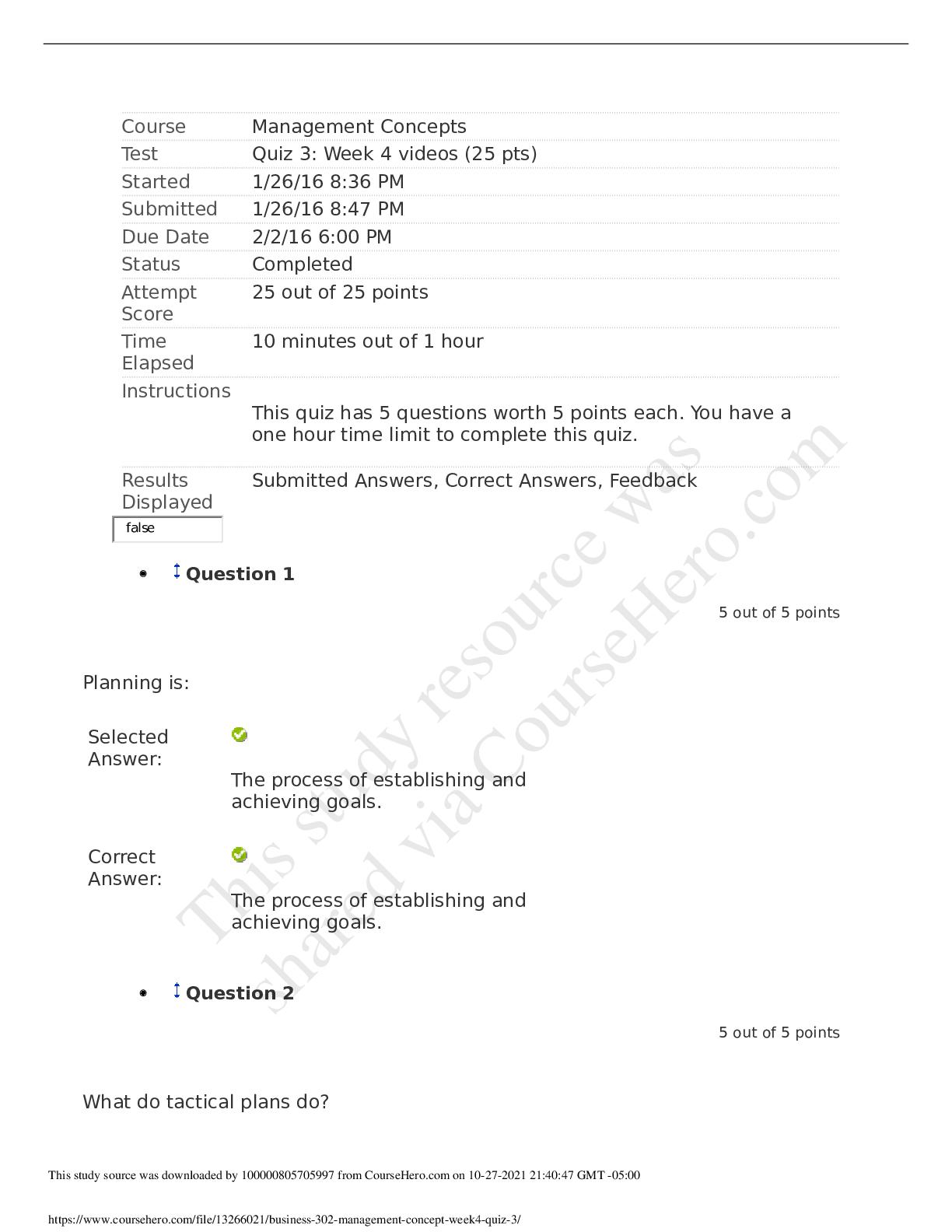

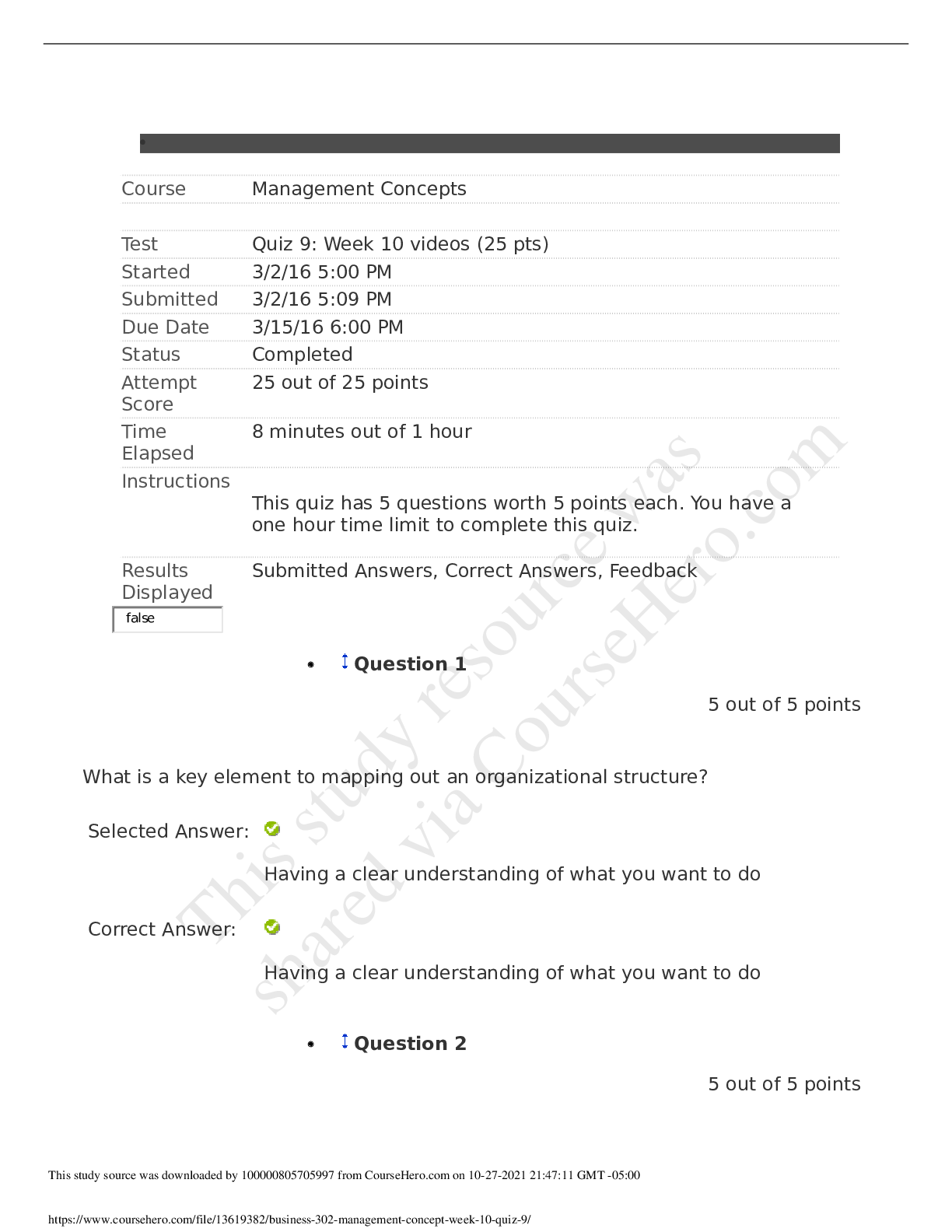

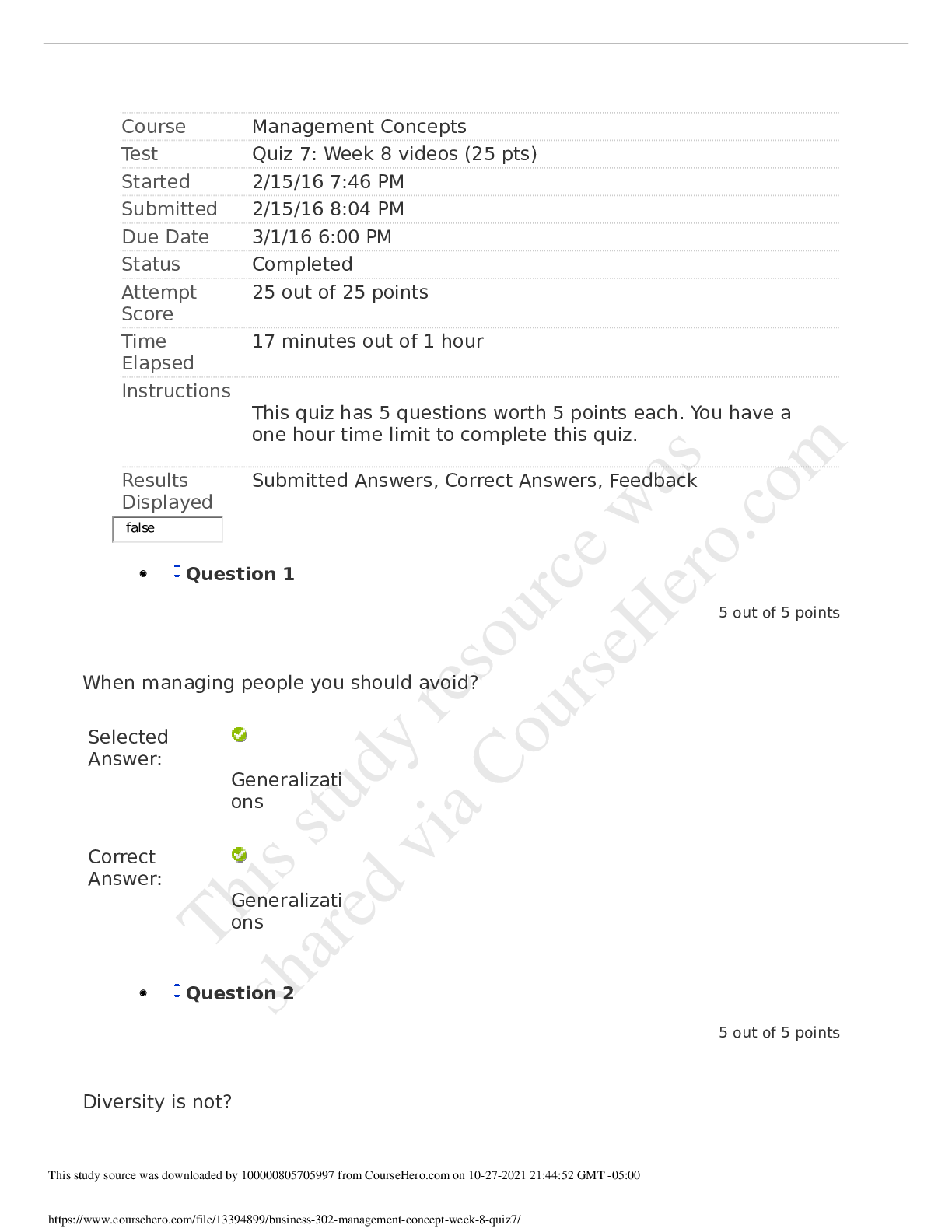

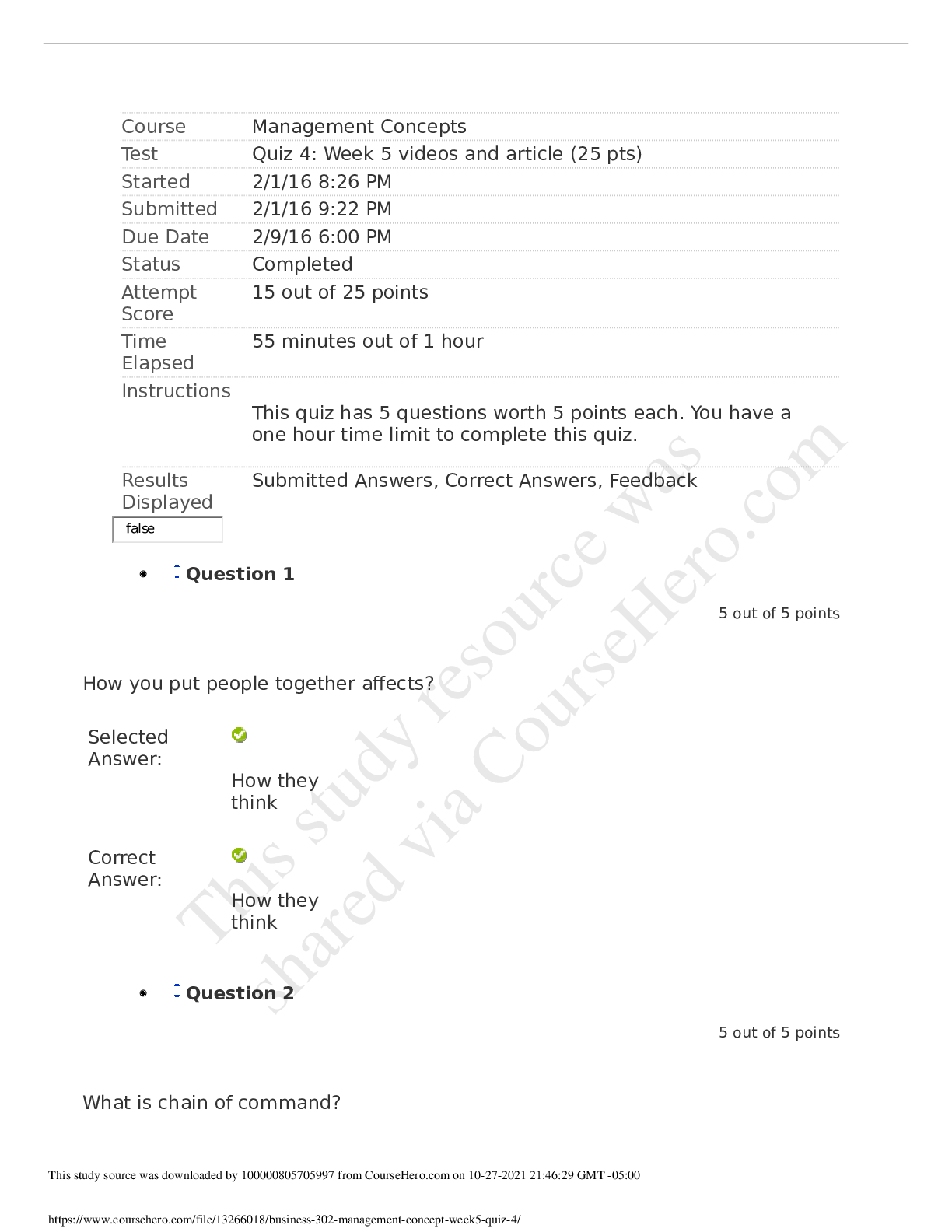


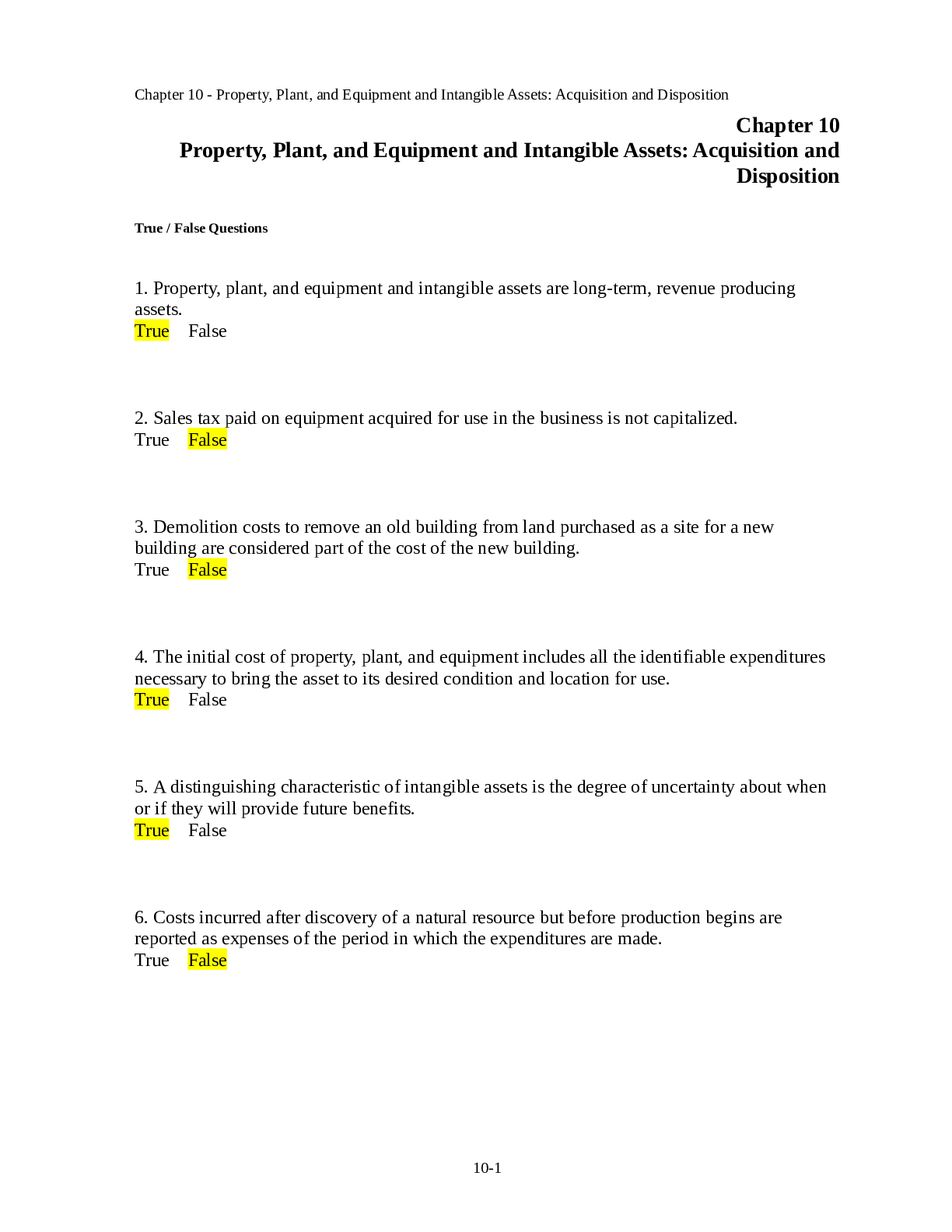
.png)


